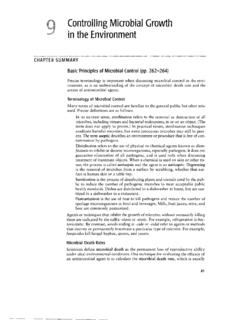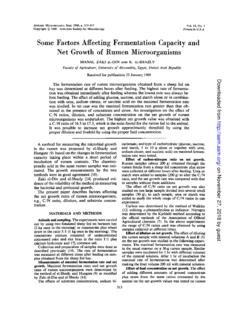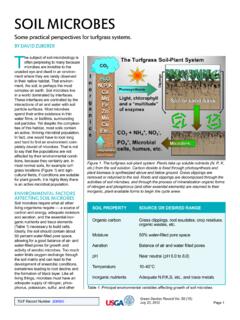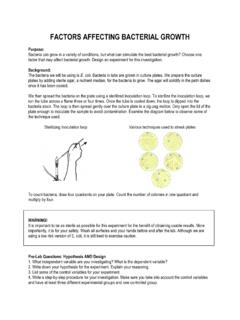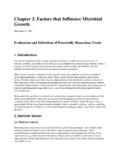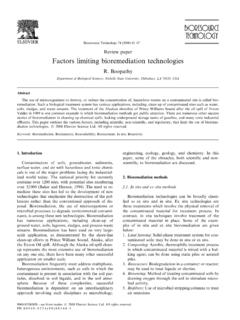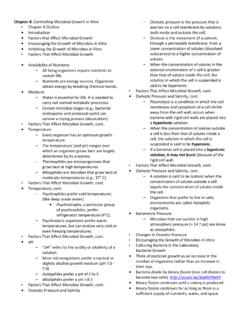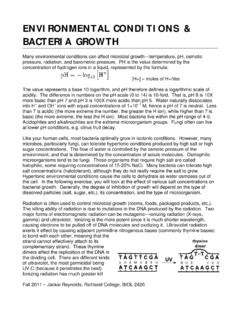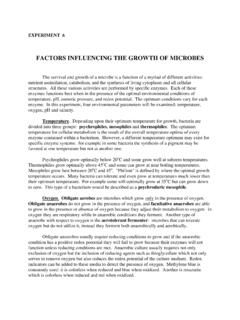Transcription of Chapter 41
1 Microbiology of Food 1 41 Copyright McGraw-Hill Global Education Holdings, LLC. Permission required for reproduction or display. microbial growth and Food Spoilage Results from growth of microbes in food alters food visibly and in other ways, rendering it unsuitable for consumption(this is not the same as foodborne pathogens) Involves predictable succession of microbes Different foods undergo different types of spoilage processes Toxins are sometimes produced Food spoilage bacteria are not specifically pathogenic bacteria 2 microbial growth and Food Spoilage microbial growth is controlled by intrinsic factors factors related to the food itself extrinsic factors environment where food stored 3 Intrinsic factors Food composition - carbohydrates mold predominates degrades food by hydrolysis little odor ergotism hallucinogenic alkaloids released by Claviceps purpurea may cause death 4 Intrinsic factors Food composition proteins or fats bacterial growth predominates Putrefaction proteolysis and anaerobic breakdown of proteins.
2 Foul smelling amine compounds Unpasteurized milk spoilage acid production followed by putrification Butter short-chained fatty acid production; rancid butter 5 Intrinsic factors continued pH impacts the make up of microbial community and therefore types of chemical reactions that occur when microbes grow in food , low pH favors yeast and mold Presence and availability of water in general, lower water activity inhibits microbial growth 6 Intrinsic factors continued Physical structure grinding and mixing distribute microbes; increases the surface area and promotes microbial growth outer skin of vegetables and fruits slows microbial growth Oxidation-reduction potential higher is preferred by aerobes and fungi altered by cooking lower redox more bacteria and anaerobes 7 Antimicrobial Substances Coumarins fruits and vegetables Lysozyme cow s milk and eggs Aldehydic and phenolic compounds herbs and spices such as rosemary, sage, cinnamon, mustard, basil Allicin garlic Eugenol - cloves Polyphenols green and black teas 8 Extrinsic factors Temperature lower temperatures slow microbial growth Relative humidity higher levels promote microbial growth Atmosphere oxygen promotes growth (high oxygen reduces growth in MAP) modified atmosphere packaging (MAP) use of shrink wrap and vacuum technologies to package food in controlled atmospheres (high CO2 frequently used and others)
3 9 Controlling Food Spoilage Methods of preservation goal is to eliminate or reduce the populations of spoilage and disease causing microbes while maintaining food quality Filtration Water, wine, beer, juices, soft drinks, and other liquids usually by filtration May better preserve flavor and aroma Low Temperatures Refrigeration at 5 C retards but does not stop microbial growth microorganisms can still cause spoilage with extended storage growth at temperatures below 10 C has been observed fruit juice concentrates, ice cream, some fruits 10 Controlling Food Spoilage cont. High Temperatures Food heated in special containers to 115 C for 25 to 100 minutes Kills spoilage microbes, but not necessarily all microbes in food Spoilage of canned foods - spoilage prior to canning, underprocessing, leakage of contaminated, water into cans during cooling process Pasteurization Kills pathogens and substantially reduces number of spoilage organisms Different pasteurization procedures heat for different lengths of time shorter heating times result in improved flavor Milk: LTH (low temp holding/batch) C for 30 mins HTST (high temp short time) 72 C for 15 secs UHT (ultra high temp) 138 C for 2 secs 11 Controlling Food Spoilage cont.
4 Water Availability Dehydration , lyophilization to produce freeze-dried foods is commonly used to eliminate bacterial growth food preservation occurs as a result of free-water loss and an increase in solute concentration Radiation Radappertization use of ionizing radiation (gamma radiation) to extend shelf life or sterilize meat, seafoods, fruits, and vegetables excellent penetrating power food not rendered radioactive kills microbes in moist foods by producing peroxides from water peroxides oxidize cellular constituents 12 Controlling Food Spoilage cont. Chemical Based Methods GRAS chemical agents generally recognized as safe agents include organic acids, sulfite, ethylene oxide gas, ethyl formate sodium nitrite inhibits spore formation in meats, forms nitrosamines pH of food impacts effectiveness of chemical preservative High Hydrostatic Pressure (HHP) Applies pressures from 100-800 milliPascals (MPs) without significant changes in temperature highly detrimental to cell membranes effective at eliminating eukaryotic microbes not as effective at elimination of Gram-positive microbes No industry standards for HHP conditions (yet) 13 14 Controlling Food Spoilage cont.
5 microbial product based inhibition Bacteriocins bactericidal proteins active against related species some dissipate proton motive force of susceptible bacteria some form pores in plasma membranes some inhibit protein or RNA synthesis , nisin from Lactococcus lactis used in low-acid foods to inactivate Clostridium botulinum during canning process , bacteriophages that kill Listeria monocytogenes sprayed onto ready-to-eat meats prior to packaging 15 Controlling Food Spoilage cont. Packaging Modified atmosphere packaging (MAP) gases in stored food affect microbial growth shrink wrap materials and vacuum technology control atmosphere impermeable to gasses high CO2 content packaging can be used to prevent fungal growth high O2 content packaging produces superoxide radicals that inhibit microbial growth 16 Types of Food-Borne Disease About 48 million cases/yr in approximately 128,000 hospitalizations at least 3,000 deaths/yr in only 14 million attributed to known pathogens Pathogens Noroviruses, Campylobacter jejuni, Salmonella are major causes E.
6 Coli and Listeria are also important pathogens Other: S. aureus, Clostridium perfringens, Bacillus cereus, Yersinia enterocolitica, Vibrio parahaemalyticus, Clostridium botulinum, Shigella 17 Types of Food-Borne Disease Two primary types food-borne infections food intoxications Transmission breakdown in hygiene fecal-oral route key fomites also important mishandling 18 Food-Borne Infection Ingestion of pathogen, followed by: growth tissue invasion and/or release of toxins (these toxins are not the same as an intoxication) Raw and undercooked foods sprouts, raspberries, cantalope, spinach meat, eggs and seafood 19 20 Food-Borne Intoxications Ingestion of toxins in foods in which microbes have grown Produce symptoms shortly after the food is consumed because growth of the disease-causing microorganism is not required Includes: staphylococcal food poisoning Botulism Clostridium perfringens food poisoning Bacillus cereus food poisoning 21 Other Food Disease Fungus-derived toxins aflatoxins carcinogens produced in fungus-infected grains and nut products fumonisins carcinogens produced in fungus-infected corn Algal toxins contaminate fish and shellfish 22 Key Food Safety Legislation Driven in part by Upton Sinclair s 1905 novel The Jungle, the Federal Meat Inspection Act was passed Other food safety legislation followed 23 Food Safety Standards Milk Testing.
7 Phosphatase Test Check for presence of phosphatase, enzyme is destroyed by heat and should not be present after pasteurization Aerobic Plate Counts Total Coliform Test MPN directly into brilliant green lactose bile Should be less than 10 coliforms/mL Cell counts Limited number of WBCs and bacteria Antibiotic sensitivity No allowable residual antibiotics 24 Microbiology of Fermented Foods Chemical changes in food brought about microbial action Major fermentations used are lactic, propionic, and alcoholic fermentations Majority of fermented milk products rely on lactic acid bacteria (LAB) in the genera Lactobacillus, Lactococcus, Leuconostoc, and Streptococcus Mesophilic (app. 20-30 C): Buttermilk/sour cream Lactobacillus spp. and Lactococcus lactis Thermophilic (app. 45 C): Yogurt Lactobacillus spp. and Streptococcus thermophilus Yeast lactic: Kefir (ferm. milk with 2% ethanol) yeasts, lactic acid bacteria, and acetic acid bacteria Mold lactic.
8 Viili (Finnish fermented milk) filamentous fungi and lactic acid bacteria 25 Cheese Production Approximately 2,000 distinct varieties representing 20 general types Classified based on texture, hardness (soft, semi-soft, hard, very hard) All from lactic acid fermentation molds may further enhance flavor 26 27 Microbiology of Fermented Foods Breads Involves growth of Saccharomyces cerevisiae (baker s yeast) under aerobic conditions maximizes CO2 production, which leavens bread Other microbes used to make special breads ( , sourdough bread) Can be spoiled by Bacillus species that produce ropiness Other Fermented Foods Sufu from fermentation of tofu Sauerkraut (sour cabbage) from wilted, shredded cabbage Pickles from cucumbers Silage from grass, chopped corn, and other fresh animal feeds 28 29 Wines and Champagnes Enology (wine production) crushed grapes separation and storage of liquid (must) before fermentation fresh must treated with sulfur dioxide fumigant Saccharomyces cerevisiae or S.
9 Liposideus added for consistent results fermented for 3 5 days at 20 28oC Distilled Spirits Similar to beer-making process begins with sour mash mash inoculated with homolactic bacterium following fermentation, is distilled to concentrate alcohol 30 Beers and Ales Cereal grains used for fermentation malt germinated barley grains having activated enzymes mash the malt after being mixed with water in order to hydrolyze starch to usable carbohydrates mash heated with hops hops provide flavor and assist in clarification of wort heating inactivates hydrolytic enzymes Similar to beer-making process begins with sour mash mash inoculated with homolactic bacterium following fermentation, is distilled to concentrate alcohol 31 Probiotics and Standardization Probiotics live microorganisms, which when administered in adequate amounts, confer a health benefit to the host specific requirements should be met Microorganisms Lactobacillus, Bifidobacterium 32 Possible Benefits of Probiotics Immunomodulation Control of diarrhea Possible modulation of Crohn s Disease Lactobacillus acidophilus and Bifidobacterium help minimize lactose intolerance improve general intestinal health and balance produce bacteriocins that are destructive to pathogens may lower serum cholesterol may have anti-tumor activity 33 Probiotic Microbes in Farm Animals Probiotics Lactobacillus acidophilus in beef cattle decrease E.
10 Coli O157:H7 Bacillus strain in poultry limit colonization of gut by the process of competitive exclusion reduces Salmonella and Campylobacter 34
